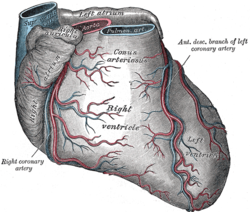Anterior interventricular branch of left coronary artery
| Anterior interventricular branch of left coronary artery | |
|---|---|

Sternocostal surface of heart. Anterior descending branch labeled at upper right
|
|
| Details | |
| Source | left coronary artery |
| Branches | septals, diagonals |
| Supplies | anterolateral myocardium, apex, interventricular septum, 45-55% of the left ventricle (LV) |
| Identifiers | |
| Latin | ramus interventricularis anterior arteriae coronariae sinistrae |
| TA | A12.2.03.202 |
| FMA | 3862 |
|
Anatomical terminology []
|
|
The anterior interventricular branch of left coronary artery, (also left anterior descending artery (LAD), or anterior descending branch) is a branch of the left coronary artery. Occlusion of this artery is often called the widow-maker infarction.
It passes at first behind the pulmonary artery and then comes forward between that vessel and the left atrium to reach the anterior interventricular sulcus, along which it descends to the notch of cardiac apex.
Although rare, multiple anomalous courses of the LAD have been described. These include the origin of the artery from the right aortic sinus.
In 78% of cases, it reaches the apex of the heart.
The LAD gives off two types of branches: septals and diagonals.
The artery supplies the anterolateral myocardium, apex, and interventricular septum. The LAD typically supplies 45-55% of the left ventricle (LV) and is therefore considered the most critical vessel in terms of myocardial blood supply.
The widow maker is an alternate name for the anterior interventricular branch of the left coronary artery. The name widow maker may also apply to the left coronary artery or severe occlusions to that artery.
This term is used because the left main coronary, and/or the left anterior descending supply blood to large areas of the heart. This means that if these arteries are abruptly and completely occluded it will cause a massive heart attack that will likely lead to sudden death. The blockage that kills is made up of platelets streaming to the site of a ruptured cholesterol plaque. Even a small amount of plaque in this area can (for a variety of poorly understood reasons) rupture and cause death; bypassing chronic blockages or trying to open them up with angioplasty does not prevent heart attack but it can restore blood flow in case of a sudden blockage or heart attack and if performed within a rapid time period can minimize the damage done. An example of the devastating results of a complete occlusion of the LAD artery was the sudden death of former NBC News Washington Bureau Chief Tim Russert.
...
Wikipedia
